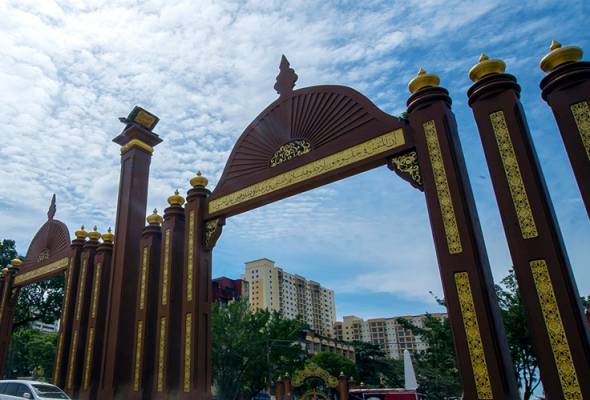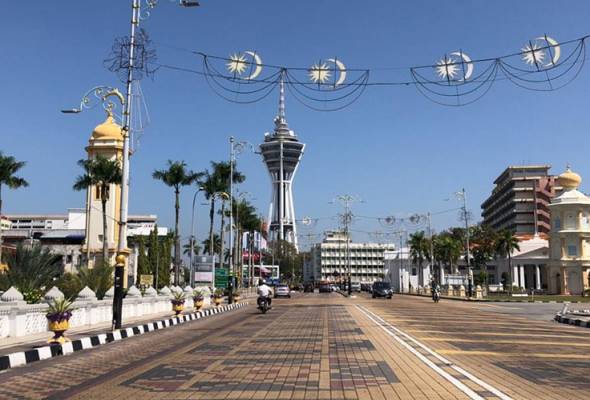
Published by AstroAwani, SinarDAILY & BusinessToday, image by AstroAwani.
While Selangor and Penang are deemed as the “frontliners” in the state election due to their status and prestige as economic powerhouses, Negeri Sembilan can well be considered as the “second frontliner”.
Although at 1.1 million, Negeri Sembilan’s population is only 15% of Selangor’s, the former is, however, only slightly smaller than the latter, i.e., at 6,656 km2 of land compared to 7,951 km2 (Smart Selangor Action Plan to 2025/SSAP 2025).
The ethnic composition of the state comprises 56.6% Malays (mainly of Minangkabau descent), 2% other Bumiputeras (principally Orang Asal), 21.3% Chinese, and 14% Indians.
Despite the population disparity, Negeri Sembilan has only 20 seats less than Selangor in the state assembly, i.e., at 36.
The relative situation of Negeri Sembilan as an “emerging” economy is loosely analogous to the “flying geese” developmental theory or paradigm (in developmental economics as propounded by Kaname Akamatsu) whereby the former will eventually catch up with the economic standards of Selangor as the “lead goose” (as well the Federal Territory of Kuala Lumpur) in the hierarchy of the global value chain (GVC).
The Negeri Sembilan Structural Plan 2045 expresses the state government’s aim “to [position the state to be on par with] Kuala Lumpur, in terms of land use, services, infrastructures, utilities and amenities”.
The challenge and task for whoever forms the state government is to ensure the integration of the Negeri Sembilan economy with particular reference to the area known as the Malaysia Vision Valley (MVV) 2.0 into the Greater KL and Klang Valley conurbations and leveraging on the spillover effect, multiplier effect, etc. from the latter.
By extension, whoever forms the state government has to ensure continuous heightened/enhanced connectivity and linkages with the Greater KL and Klang Valley regions (allowing for ease of transportation, especially for public ridership) alongside ensuring balanced development and boosting the standards of living/quality of life whilst simultaneously providing for a cost of living that’s still comparably cheaper to its more developed counterparts, as alluded to.
This requires close strategic collaboration and coordination between Selangor and Negeri Sembilan, and not in terms of federal-state relations only.
In other words, “interactive” and “concatenative” (i.e., interlocking) growth which can only happen, ideally, when the states are governed by the same coalitions or joint-coalitions as is the case at present.
That is, the geographical clustering provides the location and setting for industrial and services clustering (as the case may be) which is analogous to the production networks on a regional scale – where specialisation and division of labour can be systematically arranged and at the same time the supply-chain shortened as part of the wider reconfiguration (including cost-efficiencies).
For example, we can employ the import-substitution industrialisation (ISI) and export-oriented industrialisation (EOI) strategies to the supply-chain in relation to the respective roles of Negeri Sembilan (mid-stream as in semi-processed inputs, for example) and Selangor (downstream as in final product or outputs). This helps companies to not only shorten the supply-chain but also save costs (including on unit labour costs where Negeri Sembilan would have a comparative advantage).
Or in addition, the ISI can also envision Negeri Sembilan as a manufacturing hub producing finished goods destined for the domestic market (including East Malaysia) via Selangor as the transportation and logistical hub (based in KLIA, Shah Alam, Port Klang, etc.). At the same time, there can be domestic transhipment arrangements (where import duties are, by default, non-applicable), i.e., “importing” goods from Negeri Sembilan into Selangor for final processing and labelling and “exported” by air, land and sea throughout the country.
These goods are meant to compete with imported goods (which are priced higher due to the exchange rate pass through/ERPT) and providing a cheaper alternative – that’d help to buffer the loss of purchasing power of Malaysian consumers.
Surplus goods can be re-exported to the wider region and beyond. These goods can also subsidise the domestic/local prices (at least in the long-run).
Negeri Sembilan can even be conceptualised to be “Shenzhen” – capitalising on the lower manufacturing costs in the state – with Selangor as “Hong Kong” on the back of its established financial services as well as research and development (R&D) sectors. This would allow for an integrated production (original design manufacturing/ODM and original equipment manufacturing/OEM) and services base (vertical and horizontal) and single economic corridor/zone with the MVV 2.0 as a pivotal hub.
The development of a high-tech and industrial park by Sime Darby Property Berhad in Nilai can be complementary to Greater Kuala Lumpur and the Klang Valley (where the competitive effect can be minimised).
This can be done by envisaging part of the high-tech manufacturing processes and operations shifted and allocated between Nilai (e.g., solid state drives/SDD hardware – manufacturing and assembly phase, including cutting and moulding – part of the OEM operations) and its counterparts in Greater Kuala Lumpur (such as Cyberjaya – e.g., artificial intelligence/AI-based SDD design phase) and Klang Valley (such as Petaling Jaya – e.g., HDD software – performance testing phase – pre- and post-production – part of the OEM operations).
This is the wider policy vision and context within which, ideally, the manifestos of respective parties should be understood and framed.
As there’s no equivalent regional economic corridors like the Northern Corridor Economic Region (NERC) and East Coast Economic Region (ECER) as such, the Negeri Sembilan state government can come up with their own development agenda that simulates and mirrors that of a regional corridor via proximity and synergy – by enhancing and further developing on the pre-existing Comprehensive Development Plan (CDP) for MVV 2.0 under the MVV Secretariat.
Moving forward, the state already has high digital connectivity – with 88.9% Internet penetration rate (2020), 74.7% computer usage (2020) and 95.3% mobile phone usage (2020).
According to the Deputy Minister of Communications and Digital YB Teo Nie Ching (as of May 2023), 5G network in Negeri Sembilan has reached almost 53% coverage of populated areas (COPA) with 131 communication infrastructures completed by the telecommunications industry. She added that the Malaysian Communications and Multimedia Commission (MCMC) in collaboration with the telecommunications industry had identified and planned a total of 207 5G sites to be developed in the state this year. The target is that by the end 2023, it’s expected that the COPA should reach 80% (“Teo Nie Ching: 5G network coverage in Negeri Sembilan now at 53pc”, Malay Mail, 31 May 2023).
The state, therefore, has the necessary supporting infrastructure in place to propel it to the next stage of its development phase/stage.
In tandem, the state government – via the Negeri Sembilan Digital Economy Blueprint (2027) – is determined to capitalise the digital economy to be a key growth driver and catalyst of the state.
Indeed, the Pakatan Harapan (PH)-Barisan Nasional (BN) joint-manifesto under the tutelage of caretaker and incumbent Menteri Besar Aminuddin Harun aims to make Negeri Sembilan a developed state within 10 years.
Aptly styled as Apsirasi Perpaduan, the PH-BN joint-manifesto comprises 10 strategic pillars and 70 initiatives.
Among the 10 strategic pillars are:
- Developing a modern Negeri Sembilan 2023-2033;
- Empowering the people’s economy by improving the state’s economy and people’s well-being;
- Promoting a people-friendly development; and
- Sustaining balanced rural and urban development (including promotion of liveability).
Whereas the 70 initiatives include:
- Setting up new industrial areas;
- Setting up a dialysis centre in every constituency;
- Providing subsidies for B40 youths to obtain a motorcycle licence,
- Setting up a food tourism hub in every district;
- Building 4,000 affordable houses for families and youth under the “One House One Family and Housing for the Youth” programme within the next five years;
- Increasing the amount of the general assistance by the state welfare department to recipients from RM270 to RM300 and from RM320 to RM350 to different groups of recipients, respectively;
- Providing orthopaedic implant assistance for low-income groups;
- Providing special assistance to fishermen and the setting-up of Warisan Nelayan Fund to reduce the burden of the next-of-kin of fishermen in the event of untoward incidents involving the families’ breadwinner;
- Formulating the best approach to build houses for the second generation of Felda settlers;
- Enhancing and expanding high-speed internet coverage statewide;
- Providing the Galakan Kecemerlangan special incentive of RM1000 to Negri Sembilan children who scored straight As in Sijil Pelajaran Malaysia (SPM), Sijil Tinggi Persekolahan Malaysia (STPM) or Sijil Tinggi Agama Malaysia (STAM);
- Providing assistance in the form of laptops to Form Six students and above from B40 families;
- Providing disbursements under the Sejahtera Rakyat scheme. The scheme includes RM300 for pupils enrolling with full boarding schools and a Skim Simpanan Pendidikan Nasional (SSPN) contribution of RM100 for every newborn in the state starting this year until 2027.
On the other hand, the PN manifesto contains eight main pillars and nineteen pledges.
The pillars include:
- Driving economic resilience and addressing the rise in the cost of living;
- Creating sustainable future for the youth;
- Establishing people-centric education;
- Empowering outstanding women;
- Elevating social welfare; and
- Strengthening infrastructure and security network.
In reducing the cost of living, PN seeks to introduce the “Kad Nismilan Prihatin” which will enable lower income folks to buy basic items for selected goods.
Included in the PN manifesto also are:
- the RM300 in subsidy for first-time B2 motorcycle license among eligible youth to stimulate the gig economy in the state;
- more than RM1 million in allocation to provide up to RM15000 in grant under the Dana Tani Mudo (Young Agropreneurs Fund);
- the setting aside of sufficient allocation to carry out training programmes for young who want to become e-commerce entrepreneurs;
- establishing an e-sports hubs in every district in the state for the younger generation;
- increasing the number of rent-to-own (RTO) initiatives with affordable rates for the youth including young newly-weds couples;
- creating and increasing the number of employment opportunities in the state irrespective of skilled and semi-skilled workers; and
- optimising the use abandoned customary land (tanah adat terbiar) for farming/agricultural activities to help generate side or additional income for the participants.
A PN state government also hopes to cooperate with federal government agencies and the private sector to accelerate economic development along the border areas of Negri Sembilan and Kuala Lumpur International Airport (KLIA), including the Digital Free Trade Zone (DFTZ).
As has been announced, other than Selangor, Negeri Sembilan is also the state which PN seeks to capture and is confident of doing so, although it has no strong presence there and lacks a pivotal icon or strongman figure like the former Umno warlord Noh Omar in north Selangor (especially as embodied by and concentrated in his former parliamentary constituency of Sabak Bernam). Bersatu’s sole MP in the state, i.e., Dato’ Eddin Syazlee bin Shith lost his Kuala Pilah seat to Umno at the 15th general election of 2022.
And based on a most recent survey, the support of Malay voters in Negeri Sembilan for PH and BN has increased by more than 50% (“Support of Malay voters for Pakatan, BN in N. Sembilan increasing, says Aminuddin”, Malay Mail, August 8, 2023).
In the final analysis, the question which confronts Negeri Sembilan voters is which coalition has the political will, integrity and capacity to govern and administer this “second frontline” state to lead it to greater heights in the years to come and finally realise the vision and ambition of catching up with its counterparts and peers in the country’s domestic region.
Jason Loh Seong Wei is Head of Social, Law & Human Rights at EMIR Research, an independent think tank focussed on strategic policy recommendations based on rigorous research.

